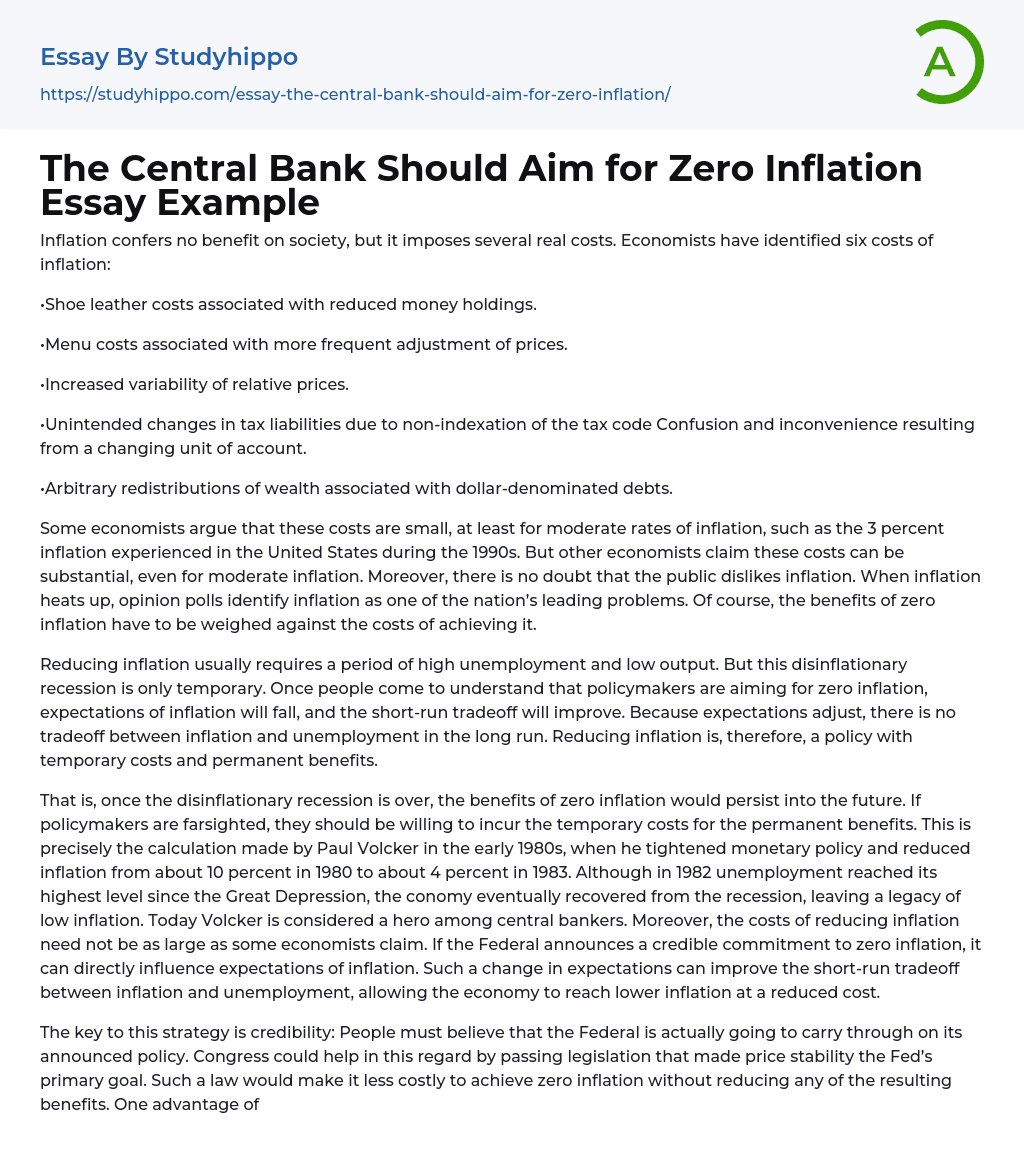

The Central Bank Should Aim for Zero Inflation Essay Example
Inflation confers no benefit on society, but it imposes several real costs. Economists have identified six costs of inflation:
•Shoe leather costs associated with reduced money holdings.
•Menu costs associated with more frequent adjustment of prices.
•Increased variability of relative prices.
•Unintended changes in tax liabilities due to non-indexation of the tax code Confusion and inconvenience resulting from a changing unit of account.
•Arbitrary redistributions of wealth associated with dollar-denominated debts.
Some economists argue that these costs are small, at least for moderate rates of inflation, such as the 3 percent inflation experienced in the United States during the 1990s. But other economists claim these costs can be substantial, even for moderate inflation. Moreover, there is n
...o doubt that the public dislikes inflation. When inflation heats up, opinion polls identify inflation as one of the nation’s leading problems. Of course, the benefits of zero inflation have to be weighed against the costs of achieving it.
Reducing inflation usually requires a period of high unemployment and low output. But this disinflationary recession is only temporary. Once people come to understand that policymakers are aiming for zero inflation, expectations of inflation will fall, and the short-run tradeoff will improve. Because expectations adjust, there is no tradeoff between inflation and unemployment in the long run. Reducing inflation is, therefore, a policy with temporary costs and permanent benefits.
That is, once the disinflationary recession is over, the benefits of zero inflation would persist into the future. If policymakers are farsighted, they should be willing to incur the temporary costs for the permanent benefits. This is precisely the calculation mad
by Paul Volcker in the early 1980s, when he tightened monetary policy and reduced inflation from about 10 percent in 1980 to about 4 percent in 1983. Although in 1982 unemployment reached its highest level since the Great Depression, the conomy eventually recovered from the recession, leaving a legacy of low inflation. Today Volcker is considered a hero among central bankers. Moreover, the costs of reducing inflation need not be as large as some economists claim. If the Federal announces a credible commitment to zero inflation, it can directly influence expectations of inflation. Such a change in expectations can improve the short-run tradeoff between inflation and unemployment, allowing the economy to reach lower inflation at a reduced cost.
The key to this strategy is credibility: People must believe that the Federal is actually going to carry through on its announced policy. Congress could help in this regard by passing legislation that made price stability the Fed’s primary goal. Such a law would make it less costly to achieve zero inflation without reducing any of the resulting benefits. One advantage of a zero-inflation target is that zero provides a more natural focal point for policymakers than any other number.
- Commercial Bank essays
- Debit Card essays
- Deposit Account essays
- Subprime Lending essays
- Bank essays
- Banking essays
- Corporate Finance essays
- Credit Card essays
- Currency essays
- Debt essays
- Donation essays
- Enron Scandal essays
- Equity essays
- Financial Accounting essays
- Financial Crisis essays
- Financial News essays
- Financial Ratios essays
- Financial Services essays
- Forecasting essays
- Foreign Exchange Market essays
- Free Market essays
- Gold essays
- Investment essays
- Legacy essays
- Loan essays
- Market Segmentation essays
- Money essays
- Personal finance essays
- Purchasing essays
- Retirement essays
- Shareholder essays
- Stock Market essays
- Supply And Demand essays
- Venture Capital essays
- American Dream essays
- Barriers To Entry essays
- Capitalism essays
- Central Bank essays
- Compensation essays
- Consumerism essays
- Economic Development essays
- Economic Growth essays
- Economic Inequality essays
- Economic System essays
- Economy essays
- Employment essays
- Export essays
- Finance essays
- Free Trade essays
- Gross Domestic Product essays



